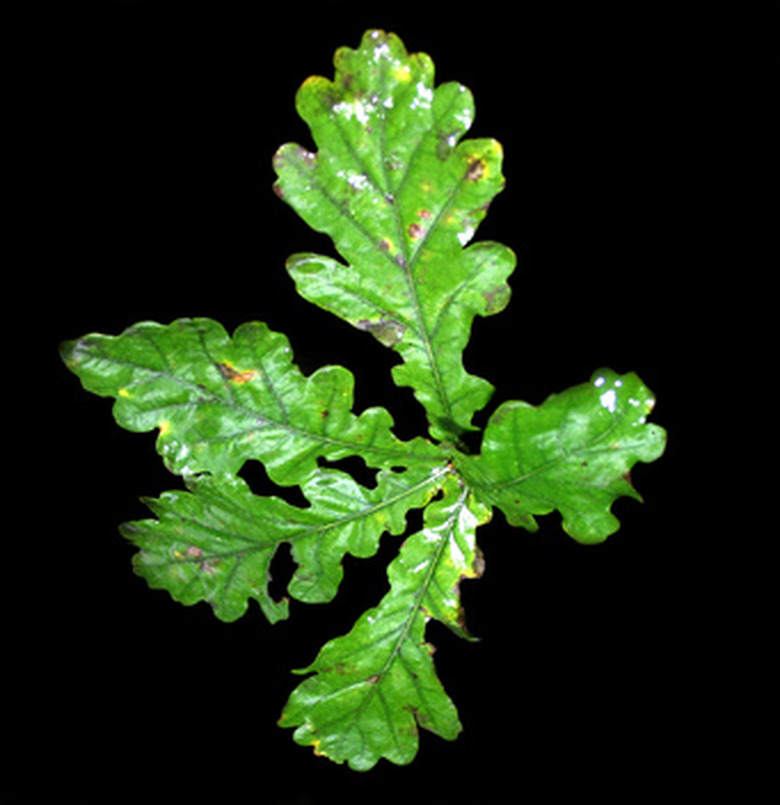How To Identify Oak Trees By The Leaf Shape
The array of oak species that occurs in North America has almost as many different leaf shapes as there are species. The oaks fall under two categories—white and red –with each oak family having varied features. Their leaf shapes vary, with some oaks having multi-lobed foliage, while others have leaves that resemble those of other trees. To identify oaks solely by the shapes of their leaves, you have to look closely at such features as the number of lobes, the sinuses that exist between the lobes and the edges of the leaves.
White Oak Leaves
Step 1
Look for rounded lobes on many of the oak species that fall within the family of white oak trees. Count the number of rounded lobes to distinguish white oak species from one another. The average species of the white oak (Quercus alba) has from seven to nine of these rounded lobes. The typical bur oak (Quercus macrocarpa) has as few as five and as many as nine lobes. Species such as post oak (Quercus stellata) average just five rounded lobes per leaf, while the Gambel oak (Quercus gambelii) has between seven and eleven lobes.
- The array of oak species that occurs in North America has almost as many different leaf shapes as there are species.
- To identify oaks solely by the shapes of their leaves, you have to look closely at such features as the number of lobes, the sinuses that exist between the lobes and the edges of the leaves.
Step 2
Inspect the sinuses of the white oak leaves carefully. Some of the sinuses can extend inward and almost reach the midrib of the leaf, while others are much shallower. White oak has variable sinuses on its leaves, with some deep and others barely indented. The bur oak has a deep sinus only on the lobes in the central part of the leaf. Oregon white oak (Quercus garryana) has deep sinuses between lobes.
Step 3
Distinguish the chestnut oaks by their foliage from their close resemblance to the leaves of the chestnut trees. The chestnut oaks, part of the family of white oaks, have oblong to oval leaves that lack lobes, but instead have a rounded set of teeth all along their edges. These oaks include the chestnut oak (Quercus prinus), the swamp white oak (Quercus bicolor) and the swamp chestnut oak (Quercus michauxii).
- Inspect the sinuses of the white oak leaves carefully.
- White oak has variable sinuses on its leaves, with some deep and others barely indented.
Red Oak Leaves
Step 1
Look for pointed lobes on the trees that fall within the red oak grouping. Again, count the lobes to discern the species. Northern pin oak (Quercus ellipsoidalis) usually has five lobes but can have as many as nine lobes. Scarlet oak (Quercus coccinea) has nine toothed lobes, while Nuttall oak (Quercus nuttalli) has from five to seven lobes.
Step 2
Examine the sinuses of the red oaks, keeping in mind that the red oaks have a much more pronounced sinus pattern than white oaks in most of their leaves. The deeper sinuses are typical of species like pin oak (Quercus palustris) and Shumard oak (Quercus shumardii). Other red oaks, like the northern red oak (Quercus rubra), feature sinuses that are not as deep.
- Look for pointed lobes on the trees that fall within the red oak grouping.
- Northern pin oak (Quercus ellipsoidalis) usually has five lobes but can have as many as nine lobes.
Step 3
Study some of the more irregular shapes of the red oak species' leaves. Turkey oak (Quercus laevis) often has just three narrow lobes, in a shape that will remind you of a turkey's foot. The blackjack oak (Quercus marilandica) has three lobes so shallow that the leaf almost has a pear shape to it. The willow oaks (Quercus phellos) have narrow foliage and the live oaks have elliptical leaf shapes, with some, like interior live oak (Quercus wislizenii), with a leaf that looks like that of holly—elliptical and with sharp teeth along the margins.
References
- "Trees of North America"; C. Frank Brockman; 1996
- "National Audubon Society Field Guide to Trees"; Elbert Little; 2008
